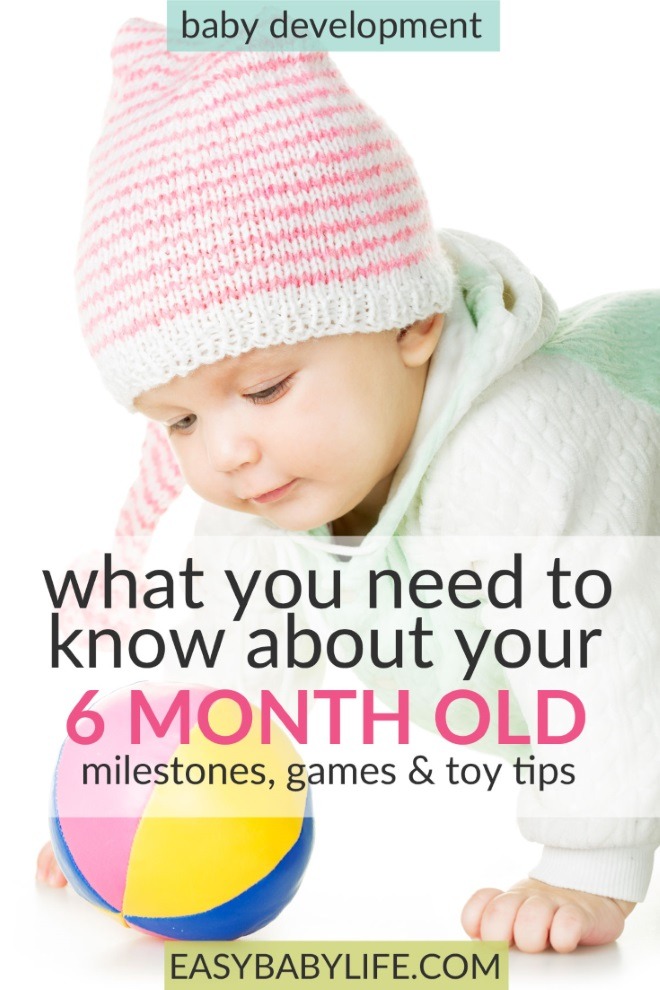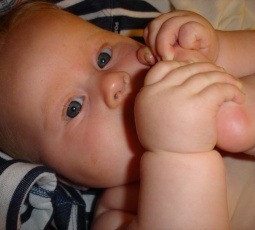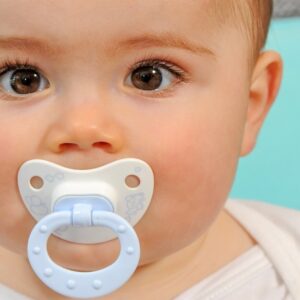Baba, dada – a 6-month-old baby is talkative! Who’s that funny guy in the mirror that I love talking to?
Here is a detailed guide to 6 months old baby development, learning activities, and the best toys!
|
 6-month-old babies are active in many ways. They are learning to eat, talk, sit, and move around. Many babies learn how to roll over if they haven’t earlier. And rolling over, again and again, means that you get somewhere.
6-month-old babies are active in many ways. They are learning to eat, talk, sit, and move around. Many babies learn how to roll over if they haven’t earlier. And rolling over, again and again, means that you get somewhere.
Exciting!
Soon enough, you will have a whole lot to do when your baby is awake. This is the beginning of a fun but intensive period – ending when your baby moves out of the house in 20 years or so…
The 6-Month-Old Baby
In this article…
6 Months Baby Milestones
Here are the development milestones to look for when your baby is 6 months old:
Physical Development
Weight and Length
Your sweet baby is growing stronger and bigger every day. The most important thing is that your baby is growing and gaining weight at a healthy rate.
The average weight for a 6-month-old baby boy is 17 pounds and 8 ounces (7.9 g) and for a baby girl, 16 pounds and 2 ounces (7.3 kg).
A 6-month-old baby boy is, on average, 26.5 inches (67.6 cm) long. The average length/height for a 6-month-old baby girl is 25.75 inches (65.7 cm).
Keep in mind that all babies are different and growing at their own pace. Maybe your baby still hasn’t reached the average weight or length for their age. Or maybe he has already passed it. As long as your baby is healthy and happy, there is not much to worry about.
Vision
Your baby’s vision is almost as good as that of an adult’s. Her depth perception has improved, and she is also able to see well across the room.
First teeth
Many babies get their first tooth at around 6 months mark. If your baby drools more than usual or seems to have an itchy mouth, it may be a tooth coming in.
Just don’t believe the old saying that babies get a fever, diarrhea, or cramps when a tooth is coming. All these symptoms indicate a sick baby and nothing else. To learn about real baby teething symptoms, click here.
Motor skills
At six months, even all our back sleepers start bringing their chests all the way off the mat and support their weight on their hands, not forearms. The baby will start working towards toys out of reach.
By now, many babies can roll over both from the stomach to the back and the opposite way. Some can also sit up with just some support or even with no support. Other babies can’t sit on their own until they are eight or nine months old.
A few 6-month-old babies start figuring out how to move around a bit by shuffling over the floor. However, most still don’t.
Some babies will start kicking hard while sitting in a baby bouncer to make it move. Don’t leave the bouncer on a table!
At around five or six months of age, babies can move objects between their hands. They also start looking for the things that they drop.
At 5-7 months, babies develop new reflexes. The old ones, for example, sucking and grasping, are gone. The new reflexes are there to help the baby if he falls. If he falls forward, he will now extend his arms and hands in front of him.
Cognitive and Social Development
Communication
6-month-old babies babble a lot! They sometimes tend to get stuck in a certain sound, for example, one syllable like “ma” or “ba,” practicing it all day long. Then they suddenly switch to another.
A 6-month-old is also making specific sounds depending on the emotion. You’ll notice your baby makes different sounds when happy, sad, or frustrated.
Your baby will also enjoy having a conversation with you and happily respond to you with her own sounds. Have a back-and-forth conversation with your baby.
Stranger anxiety
Although stranger anxiety is slowly increasing, the 6-month-old baby is still mostly happy to meet other people. He or she might even be the one initiating a “conversation.”
6-Month-Old Baby Sleep
By 6 months, many babies are sleeping through the night or for longer stretches. Don’t worry if your baby is still waking up frequently. All babies are different.
Some babies’ sleep routines might become disrupted at this point, and it might seem that your baby’s sleep behavior is worse than before. There might be several reasons for it, such as a 6-month sleep regression or teething.
Once your baby is able to roll over independently, don’t worry if he rolls over on his tummy during sleep. The risk of SIDS is much lower at this point than before.
Developmental red flags for a 6-month-old baby
All babies develop at their own pace. Your baby may not have reached some of the above-mentioned milestones yet. Don’t worry because every baby has a unique timeline when it comes to development. However, there are some warning signs you should keep an eye on.
Talk to your pediatrician if by reaching 6 months of age, your baby:
- Didn’t double his birth weight
- Still has crossed eyes
- Can’t hold his head up
- Can’t bring hands or other objects to his mouth
- Doesn’t reach for objects
- Doesn’t roll over in either direction
- Doesn’t respond to sounds around him
- Doesn’t make vowel sounds (“ah,” “eh,” “oh)
- Seems uninterested in you and doesn’t show affection
- Doesn’t smile and laugh
- Doesn’t make sounds
- Seems very stiff or very floppy
Learning Activities and Games To Play
 Your baby’s understanding of language is now well enough developed to start practicing baby sign language if you like. This is a fairly new thing for hearing babies. It has been shown, though, that babies that learn to sign may actually talk earlier and will cry less as it is easier for them to make themselves understood.
Your baby’s understanding of language is now well enough developed to start practicing baby sign language if you like. This is a fairly new thing for hearing babies. It has been shown, though, that babies that learn to sign may actually talk earlier and will cry less as it is easier for them to make themselves understood.
Imitating sounds is fun! Imitate your baby’s babbling.
As their eye-hand coordination continues to develop, your baby might enjoy some practicing. If he/she has started eating solid food, try giving them small pieces of baby crackers or rice to pick up.
Picking up toys from a bag can also be exciting and fun. Try putting toys made of different materials into the bag for some extra stimulation.
Meeting other babies can be of great interest right now. Not that they will play together, but just seeing another one “like me” seems to be interesting.
Best Toys for a 6-Month-Old
Once your baby has learned to sit without support, a roly-poly toy is great fun.
Toys that make a sound when you shake them, turn them around, or squeeze them, are good now when your baby can use both his hands.
Does your baby like walking? My daughter decided walking was all she wanted at six months. Not that she could.
I had to choose between walking with her more or less every minute she was awake or listening to her angry screams. So tiresome! Then I bought a baby walker. What a relief!
Walkers do come with two serious warnings:
- They will not help your baby learn how to walk faster.
- They can also be dangerous if your baby is left unattended in the walker. They can reach much higher, and they can run into things.
But as a toy used during short periods near someone watching over them, they can be great for young, impatient, walking babies! Lots of baby walkers are of poor quality, so research them carefully before buying one.
The 6-Month-Old Baby on Video
In this video with 6-month-old babies, you can see that they are often much stronger and in better control of their limbs than just a month ago. Some sit really well without support now.
Where would you like to go next?
Read Next About the 6-Month-Old Baby
- Feeding schedule for the 6-8-month old baby
- 6-month old rolling the eyes back
- All posts about 6-month-old babies
|

Paula Dennholt founded Easy Baby Life in 2006 and has been a passionate parenting and pregnancy writer since then. Her parenting approach and writing are based on studies in cognitive-behavioral models and therapy for children and her experience as a mother and stepmother. Life as a parent has convinced her of how crucial it is to put relationships before rules. She strongly believes in positive parenting and a science-based approach.
Paula cooperates with a team of pediatricians who assist in reviewing and writing articles.






